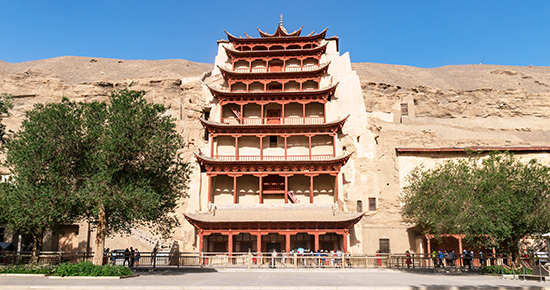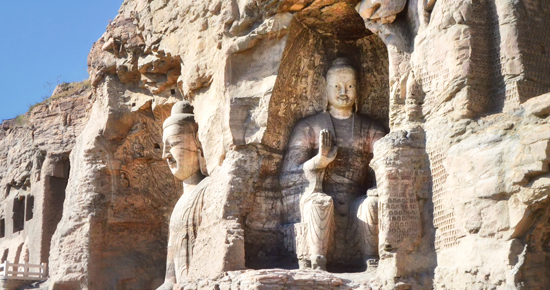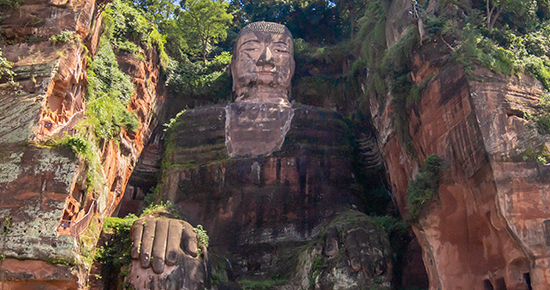Buddhist Caves/Grottos
Chinese Buddhist caves and grottos, first dug in around the third century, prevailing from the fifth to eighth century, stopped gradually exploring from the 1500s. The surviving Buddhist caves and grottos are mainly distributed in Xinjiang, western Gansu, the Yellow River Basin, and the Yangtze River Basin. Some are scattered in the north China. Myriads of skillful craftsman, basing the grottos and caves on the then religious belief, social morals, their own life experiences and alien arts, achieved the great success in paintings and sculptures that reflect the thoughts, culture and social life of Chinas feudal periods.
Mogao Grottoes
As an important strategic location on the Silk Road in the ancient times, the place Mogao Grottoes locates was not only a transfer station of east-west trade but also an intersection where oriental and western religions, cultures and knowledge met. Constructed on the bluff at the eastern foot of Mount Mingsha, Mogao Grottoes or Western Thousand Buddhas Caves, is among the Four Greatest Grottoes of China as well as the largest and most well-preserved treasure house of Buddhist culture and arts in the world. Hailed as the most valuable cultural discovery in the 20th century, Mogao Grottoes gets great fame all over the world for exquisite murals and sculptures. The construction started from year 366 during the Sixteen Kingdoms Period (304-439) and lasted in following dynasties for almost one thousand and five hundred years, which make Mogao Grottoes a sacred land of Buddhism finnaly.

Stretching foe over 1600 meters from south to north, Mogao Grottoes still keep 735 caves well-preserved with 4.5 square meters murals, 2415 colored clay statues and more than 50,000 historical relic, from all of which a new study – Dunhaung Studies – derived. Due to its brilliance in ancient culture, Mogao Grottoes was added to the World Cultural Heritage list by the UNESCO in 1987. The existing 735 caves of Mogao Grottoes can be divided into the southern area (with 487 caves) where monks held Buddhist activities and the northern area (with 248 caves) which was mainly used as a place where monks cultivated and lived as well the graveyard where monks were buried after their death. According to statistics, 492 of the 735 caves are home to existing murals and sculptures. Being the largest, longest and richest art gallery of Buddhism in the world, all of murals of Mogao Grottoes can stretch for over 30 km if arranged in a line. The themes of the murals are various, ranking from Buddhas, flying Apsaras, fairy maidens to stories about Buddhist sutras, with exquisite vignettes. Among the over 2000 colored statues of Buddhas in Mogao Grottoes, there is one sitting Buddha reaching as high as 33 meters as well as one is less than 20 centimeters in height. In addition, a great number of ancient Buddhist sutras, writs, scroll paintings, and so on, have also been found in a closed stone room in Mogao Grottoes.
The Longmen Grottoes
Situated on the banks of Yi River in the southern suburb of Luoyang City, Longmen Grottoes is commonly listed among the Four Great Grottoes of China together with Mogao Grottoes in Dunhuang, Yungang Grottoes in Dunhuang and Mount Maiji Grottoes in Tianshui.
The creating of Longmen Grottoes started from around year 493 when Emperor Xiaowendi of Northern Wei Dynasty (368-534) moved the capital from Pingcheng (known as Datong today) to Luoyang. Hailed as the No.1 among the most famous eight landscapes in ancient Luoyang, Longmen Mountain was recognized as an advantageous place in Chinese Fengshui, which made it the site for the grottoes. After a long intermittent project lasting over 400 years after Northern Wei, a spectacular grotto stretching for one kilometer from south to north emerged on the cliffs of the mountains by Yi River.

Among all the caves in Longmen Grottoes, that completed by Northern Wei Dynasty and Tang Dynasty account for the majority, reaching up to 30% and 60% respectively. Impacted by aethestic standards of the times, two dynasties show widely different styles in carving statues of Buddhas. The ones of Northern Wei look vivacious, comely, tender and slim, while the Tang's are much plumper.
In addition, Longmen Grottoes is also a treasure house of Chinese calligraphy. Not only do the inscriptions found in the grottoes record why the statues of Buddhas were carved but also they are essential Chinese calligraphy themselves. Nowadays, Chinese characters in Wei-style are still widely used in slogans and decoration.
Being the artistic expression of Buddhism culture, Longmen Grottoes also keep a good deal of materials about politics, economy, culture, religion, arts, architecture, calligraphy, music, medicine, costume, etc. Hence, it is also hailed as a large-scale comprehensive museum of ancient Chinese history.
Up to this day, there are still over 2000 cave shrines, over 2860 pieces of inscriptions, over 70 Buddhist pagodas and more than 100,000 statues of Buddhas (with the height ranging from 17.14 meters to 2 centimeters) existing there. These relics make Longmen Grottoes the top one among all famous ancient grottoes of China in quantity. On November 30 of 2000, Longmen Grottoes was added to the World Cultural Heritage list by the UNESCO.
The Yungang Grottoes
The Yungang Grottoes, located in Datong City, Shanxi Province, China, is one of the renowned treasure troves of cave art in the country. Originating in 384 AD, it has a long history spanning several centuries and is hailed as a masterpiece of ancient Chinese carving art. With a total of 53 caves, predominantly Buddhist, the Yungang Grottoes boast a diverse collection of Buddha statues, reliefs, and murals, showcasing the unique style and rich historical ambiance of the era. Amongst these exquisite stone carvings, the most famous is the Great Buddha Hall, which houses the world's tallest suspended Buddha statue. Recognized as a UNESCO World Heritage site, the Yungang Grottoes attract countless domestic and international visitors who come to admire and study its wonders. It is not only a treasury of art but also a gem of Chinese civilization, embodying the remarkable accomplishments and wisdom of ancient Chinese culture.

Leshan Giant Buddha
The Leshan Giant Buddha, which was chiseled on the cliff where the Min River, the Qingyi River and the Dadu River flow together, is the world's largest stone-carved Buddha so far. The giant sitting Buddha was proposed to be built by Monk Haitong in a bid to weaken the flow of water and reduce water disaster. It was carved from 713 AD and not completed until 803 AD, costing an unprecedented amount of manpower and material resources. On December 16th of 1996, this massive spectacular Buddha statue was officially authorized as "World Cultural and Natural Heritage" and was placed on the World Heritage List by the UNESCO (United Nations Educational, Scientific and Cultural Organization).
